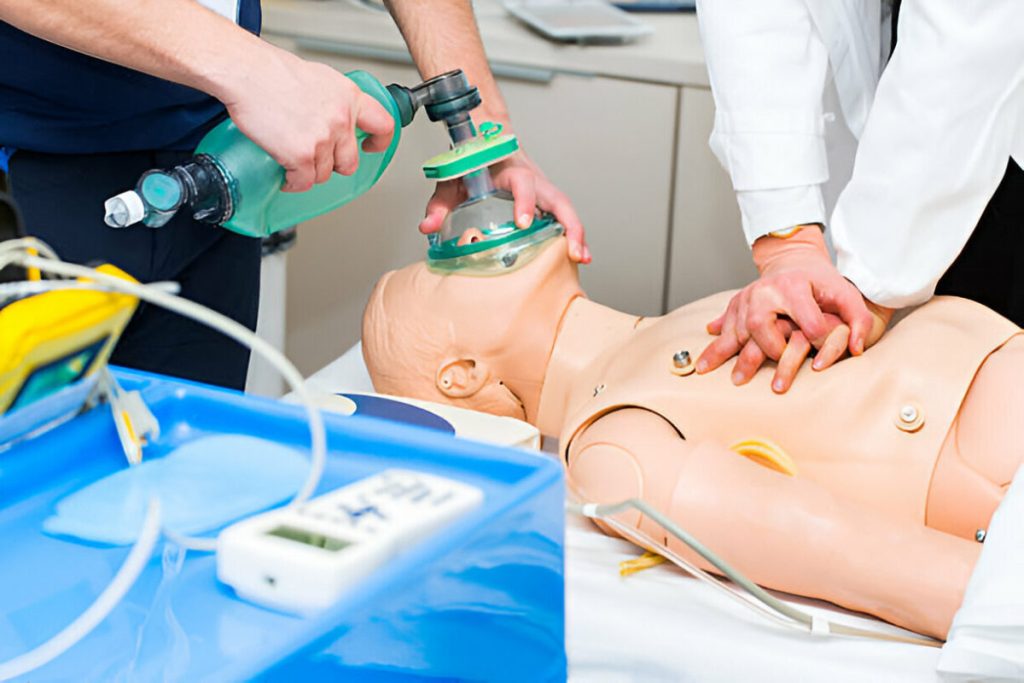In emergency medical situations, the ability to quickly recognize respiratory distress and provide appropriate interventions can mean the difference between life and death. Bag-valve-mask (BVM) ventilation is a critical skill for healthcare providers, first responders, and anyone trained in advanced life support techniques. This article explores the essential indicators that help identify patients requiring BVM ventilation and provides guidelines on delivering the correct volume of air for BVM ventilation to ensure optimal patient outcomes.
Understanding BVM Ventilation: The Basics
Bag-valve-mask ventilation is a manual technique used to provide positive pressure ventilation to patients who cannot breathe adequately on their own. The device consists of a self-inflating bag, a valve system, and a face mask that creates a seal over the patient’s mouth and nose. When properly administered, BVM ventilation delivers oxygen-enriched air to the lungs, supporting respiratory function until additional interventions can be implemented.
Before discussing when to use BVM ventilation, it’s essential to understand its fundamental purpose: to provide temporary respiratory support by delivering the correct volume of air for BVM ventilation to patients experiencing respiratory compromise. This life-saving intervention requires proper assessment, technique, and timing.
Key Indicators for BVM Ventilation Requirement
Respiratory Rate Abnormalities
One of the most immediate signs that a patient may require ventilatory assistance is an abnormal respiratory rate. In adults, a normal respiratory rate typically ranges from 12 to 20 breaths per minute. Rates falling outside these parameters warrant close attention:
- Bradypnea: Respiratory rates below 12 breaths per minute may indicate respiratory depression, often caused by drug overdoses, neurological disorders, or metabolic disturbances.
- Tachypnea: Rates exceeding 20 breaths per minute frequently signal respiratory distress, which could be due to pneumonia, pulmonary edema, or anxiety.
- Apnea: The complete absence of breathing requires immediate intervention with BVM ventilation.
When monitoring respiratory rates, healthcare providers should also observe the pattern and quality of breaths, as irregular patterns often precede respiratory failure.
Assessment of Breathing Quality and Effort
The effort and effectiveness of a patient’s breathing provide crucial insights into respiratory function. Signs indicating the need for BVM ventilation include:
- Increased work of breathing: Visible use of accessory muscles, nasal flaring, and intercostal retractions
- Paradoxical breathing: Chest and abdomen move in opposite directions during respiration
- Shallow breaths: Insufficient tidal volume that fails to adequately ventilate the lungs
- Gasping respirations: Irregular, ineffective breathing attempts
- Stridor or wheezing: Audible sounds indicating airway obstruction
These signs suggest that despite the patient’s efforts, they cannot maintain adequate ventilation, necessitating support with the correct volume of air for BVM ventilations.
Oxygen Saturation Levels
Pulse oximetry provides valuable data about a patient’s oxygenation status. Under normal circumstances, oxygen saturation should remain above 94% in healthy individuals breathing room air. Values below this threshold may indicate the need for supplemental oxygen, while persistent readings below 90% despite oxygen therapy often signal the need for BVM ventilation.
However, it’s important to note that pulse oximetry readings may lag behind actual physiological changes. By the time oxygen saturation drops significantly, the patient may already be experiencing severe hypoxia. Therefore, oxygen saturation should be considered alongside other clinical indicators rather than in isolation.
Level of Consciousness and Mental Status Changes
Changes in mental status often correlate with respiratory compromise. The Glasgow Coma Scale (GCS) offers a structured approach to assessing consciousness. Patients with compromised GCS scores, particularly those below 8, frequently require airway protection and ventilatory support.
Observable mental status changes that may indicate the need for BVM ventilation include:
- Confusion or disorientation
- Agitation followed by lethargy
- Inability to follow commands
- Unresponsiveness to verbal or painful stimuli
These changes often reflect cerebral hypoxia resulting from inadequate ventilation, highlighting the urgency of providing the correct volume of air for BVM ventilations.
Special Patient Populations Requiring Different Assessment Approaches
Pediatric Patients
Children present unique challenges in respiratory assessment due to their anatomical and physiological differences. Signs that a pediatric patient may require BVM ventilation include:
- Respiratory rates outside age-appropriate norms:
- Infants (0-1 year): Normal rate 30-60 breaths/minute
- Toddlers (1-3 years): Normal rate 24-40 breaths/minute
- Preschoolers (3-6 years): Normal rate 22-34 breaths/minute
- School-age (6-12 years): Normal rate 18-30 breaths/minute
- Adolescents (12-18 years): Normal rate 12-20 breaths/minute
- Head bobbing with respirations
- Grunting or moaning sounds during exhalation
- Seesaw breathing pattern
- Decreased responsiveness or activity level
With pediatric patients, respiratory deterioration can progress rapidly, making prompt recognition and intervention with appropriate BVM technique essential.
Geriatric Patients
Elderly patients may present with subtle signs of respiratory distress that can easily be overlooked. Key indicators include:
- Changes from baseline mental status
- Unexplained agitation or new confusion
- Reduced exercise tolerance
- Inability to complete sentences
- Asymmetrical chest expansion
Comorbidities common in geriatric populations, such as chronic obstructive pulmonary disease (COPD) or heart failure, may complicate assessment and necessitate a more nuanced approach to BVM ventilation.
Delivering the Correct Volume of Air for BVM Ventilations
Once the need for BVM ventilation has been established, delivering the appropriate volume of air becomes paramount. Overventilation can lead to gastric distension, aspiration, and barotrauma, while underventilation fails to adequately oxygenate the patient.
Adult Ventilation Guidelines
For adults requiring BVM ventilation:
- Tidal volume: Approximately 6-7 mL/kg of ideal body weight
- Ventilation rate: 10-12 breaths per minute (one breath every 5-6 seconds)
- Inspiratory time: 1-2 seconds per breath
- Visible chest rise: The primary indicator of adequate ventilation
Using the correct volume of air for BVM ventilations means delivering just enough to produce a visible chest rise without excessive force or volume.
Pediatric Ventilation Considerations
When ventilating pediatric patients:
- Tidal volume: 5-7 mL/kg of body weight
- Ventilation rate:
- Infants and children: 12-20 breaths per minute
- Adolescents: 10-12 breaths per minute
- Pressure: Lower inflation pressures than adults (typically 15-20 cm H₂O)
Pediatric patients are particularly susceptible to the adverse effects of overventilation, making careful attention to the correct volume of air for BVM ventilations especially important in this population.
Common Challenges and Troubleshooting BVM Ventilation
Mask Seal Issues
Perhaps the most common problem encountered during BVM ventilation is achieving and maintaining an adequate mask seal. Poor seal results in air leakage, reduced tidal volume delivery, and ineffective ventilation. Techniques to improve mask seal include:
- Using an appropriate mask size for the patient’s facial anatomy
- Employing the E-C clamp technique (using thumb and index finger to create a “C” around the mask while the remaining fingers form an “E” along the mandible)
- Applying gentle downward pressure to create a seal without compromising the airway
- Considering the two-person BVM technique for difficult cases
Airway Obstruction Management
Upper airway obstruction can prevent effective BVM ventilation despite correct technique. Interventions to address obstruction include:
- Head-tilt, chin-lift maneuver (unless cervical spine injury is suspected)
- Jaw-thrust technique for patients with potential spinal injury
- Insertion of airway adjuncts (oropharyngeal or nasopharyngeal airways)
- Suctioning to clear secretions or foreign material
Recognizing and addressing airway obstruction is essential for ensuring the correct volume of air for BVM ventilations reaches the lungs.
Resistance to Ventilation
If resistance is encountered during ventilation attempts:
- Reposition the head and neck to optimize airway alignment
- Check for and address any mechanical obstruction
- Consider the possibility of underlying pathology, such as bronchospasm or tension pneumothorax
- Evaluate for gastric distention, which may be limiting diaphragmatic excursion
Persistent resistance despite troubleshooting may indicate the need for advanced airway management techniques.
Training and Certification: Building Competence in BVM Ventilation
Developing proficiency in recognizing patients who need BVM ventilation and delivering this intervention effectively requires formal training and regular practice. Healthcare providers and first responders should pursue certification through accredited programs that provide comprehensive education and hands-on experience.
Regular recertification ensures that providers maintain their skills and stay updated on the latest evidence-based practices regarding the correct volume of air for BVM ventilations and associated techniques.
Conclusion: The Importance of Prompt Recognition and Intervention
Recognizing patients who need BVM ventilation represents a critical skill in emergency medicine. By understanding the key indicators of respiratory compromise and developing proficiency in BVM technique, healthcare providers can deliver life-saving interventions when they matter most.
Remember that ventilation is a dynamic process requiring continuous assessment and adjustment. The ability to recognize deterioration, initiate appropriate interventions, and deliver the correct volume of air for BVM ventilations can dramatically improve outcomes for patients experiencing respiratory distress.
Take Action: Get Certified in CPR and BVM Techniques
Don’t wait until you’re faced with a respiratory emergency to develop your skills. CPR certification St. Louis offers comprehensive training programs that include detailed instruction on BVM ventilation techniques and patient assessment. As an American Heart Association training site, CPR St. Louis provides hands-on experience with expert instructors in a supportive learning environment.
Whether you’re seeking initial certification or renewal in BLS for Healthcare Providers, ACLS, PALS, or CPR and First Aid courses, CPR certification St. Louis has a program designed to meet your needs. All classes are stress-free and emphasize practical skills development. Experience why we’re known as the best CPR in St. Louis and take the first step toward mastering these life-saving interventions today.
Contact CPR St. Louis to schedule your training and gain confidence in your ability to recognize patients who need BVM ventilation and deliver appropriate care when it matters most.





